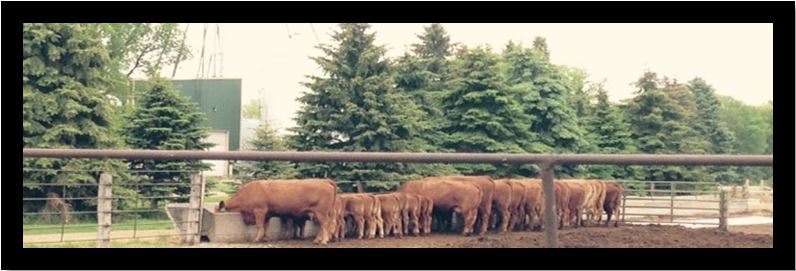Alternative Summer Cow Nutrition: Feeding Cows in the Drylot
During the past 8 years, the CREC livestock unit has conducted focused research comparing year round alternative drylot management compared to a more traditional system of winter dry lot/summer pasture management.
Many producers are looking at this alternative cow management system for a variety of reasons. As a result we have been receiving several requests for example rations for feeding cows managed in a drylot throughout the summer. Feeding cows in the dry lot for the summer is not much different than in the winter, the big difference is adjusting the diets for the different stages of production.
We often see cow diets expressed on a percent of nutrient concentration in the diet such as percentage of crude protein (CP) and energy expressed as percentage of total digestible nutrients (TDN). The cow does not have a requirement for a percentage of nutrient, they have a requirement for a total amount of nutrient and these requirements change based on cow size and stage of production. Table 1 shows the TDN and CP expressed in total pounds required per head per day for cows at three different body weights and three main stages of production.
Notice both protein and energy requirements are greatest post calving, are lowest during the middle third of pregnancy and begin to increase again during the last third of pregnancy.
Table 2. lists two diets utilizing similar feed ingredients ( wheat straw, corn grain, modified corn distillers grain and a vitamin and mineral supplement containing an ionophore) but at different concentrations of the diet. Diet 1 is 76.8% dry matter and has an overall concentration of TDN = 59.0% and CP = 10.1% and a ration cost of $0.046/lb of diet on an as fed (wet basis). Diet 2 is 73.7% dry matter and has an overall concentration of TDN = 69.0% and CP = 12.2% and has a ration cost of $0.042/lb of diet on an as fed basis.
If we take these two diets and look at the nutrient needs for the post calving cows (table 1), diet 1 would need to be fed at 2.0% of body weight on a dry matter basis to meet the nutrient requirements of these cows (table 3.). The dry matter intake (DMI) would range from 26 lb/head/day for a 1200 lb mature cow to 28 lb/head/day for a 1400 lb cow. The diet is 76.8% dry matter so the actual feed delivered to the bunk would range from 34 lb/head/day (26 divided by percent dry matter of the diet 0.768) to 36.5 lb/head/day. The diet cost/head/day ranges from $1.55 to $1.66.
Since diet 2 is more nutrient dense or has a higher concentration of nutrients (both CP and TDN) we can feed less (Table 4). To meet the nutrient needs of a post calving cow diet 2 needs to be fed at 1.7% of body weight on a dry matter basis. Subsequently this diet also reduces the daily cow feed costs by 30 cents per cow per day.
This example demonstrates we don’t need to feed the cow all she can physically eat, we just have to feed her to meet her nutrient needs. Some cows can physically consume as much as 3.0% of her body weight in feed. These are only a few options that are available for feedstuffs in North Dakota, the options are plentiful. It is critical to test feedstuffs, know the size and nutrient requirements for the cows being fed, and balance the diet accordingly. For more information on Drylot beef cow/calf production check out the NDSU publication AS974 at https://www.ag.ndsu.edu/publications/livestock/drylot-beef-cow-calf-production/as974.pdf . Additional research information on drylot production and nutrition can be found at https://www.ag.ndsu.edu/CarringtonREC/livestock/cow-calf-production.

Chanda Engel
Livestock Research Specialist


